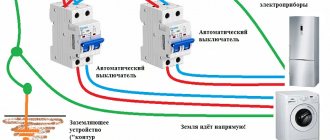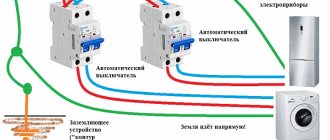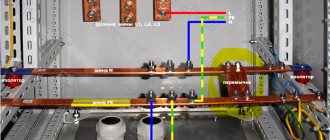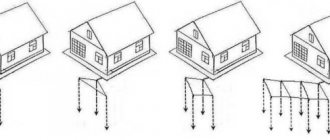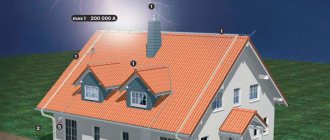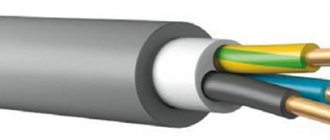What happens if you connect ground instead of zero?
Modern electrical wiring is carried out according to a three-wire circuit, with protective grounding. And if a phase wire can be found in a three-core cable with a regular indicator screwdriver, then in order to distinguish zero from grounding it is necessary to use additional devices.
Therefore, some “experts” do not pay attention to which wire is connected to the neutral and which to the ground. This article discusses the question of whether such a connection diagram is acceptable and what will happen if you connect ground instead of zero.
Method for generating electricity according to Belousov
Valery Belousov has been studying lightning and protection against it for many years. He is the author of books on free energy and has developed a number of solutions to get electricity from the ground.
In the diagram you can see two grounding symbols. Here one of them is a grounding conductor, and the second, next to which the letter “A” is the zero of the household electrical network. The following video demonstrates the operation of such a setup and describes the results obtained with its help:
The resulting energy is enough to power a low-power 220-volt LED lamp. This method is convenient to use in the country, it can be easily reproduced at home.
It is possible to obtain free electricity from the ground with your own hands. But it’s difficult to talk about practical application and connecting powerful consumers. You can't start a refrigerator like that. To date, the only well-studied source of electricity from the bowels of the earth is natural resources, such as coal, gas, fuel for nuclear power plants, etc.
You probably don't know:
In this article I will talk about grounding, which is recommended and used in the construction of private houses. I will go into detail about what a grounding device should be like and how to install it. I will tell you about the modular pin grounding system, the materials used in the grounding device, and methods for monitoring the reliability of the grounding source.
Contents: (hide)
Why do you need zero in the electrical network?
Power supply to modern residential areas and industrial enterprises is carried out using the TN system, or with a solidly grounded neutral. This means that the secondary windings of the step-down transformer are connected in a “star” configuration, the middle point of which is connected to the substation ground loop without interruption.
In a TN power supply system, the neutral conductor performs two functions:
| Information! In some types of electrical cables with a cross-section of more than 4 mm², the neutral core is made of thinner wire. |
Why is grounding needed?
In a normal situation, no current flows through the grounding conductor; it is used only in the event of an emergency. Contact of high voltage with the body of an electrical appliance and subsequent touching of it is dangerous to human life, therefore, according to the PUE clause 1.7.32-33, it is recommended to connect all metal parts to the ground loop with a separate wire or using the appropriate terminal in the socket.
In this case, if the insulation between the live parts and the grounded body is broken, a short circuit appears in the network and the current in the phase wire increases sharply, which leads to the protection being triggered.
If a short circuit to the body of an electrical appliance occurs through some resistance, then the flowing current may not be enough to trip the circuit breaker. The role of grounding in this case is to reduce the touch voltage to a safe value, thereby reducing the potential difference between a person and damaged equipment. The smaller the potential difference, the smaller the current flowing through a person.
Theft of electricity through grounding
If someone decides to use a water pipe as ground in an apartment, then he should know that he is putting someone’s life in mortal danger. The fact is that in normal condition, water pipes are actually connected to the ground (unless some kind of polymer pipe connections are used), but in the case of, for example, repairing a pipe, when it is cut below the connection point of the grounding conductor, there is a direct threat to life person touching the pipe.
Will there be step voltage?
Step voltage appears when a live wire touches the ground and current flows across the surface of the earth.
Theoretically, if all the requirements for the grounding loop specified in PUE-7 clause 1.8.39 are met, when using grounding instead of zero, step voltage should not arise, but in practice these rules are not always followed, especially if the loop was made independently and its primary and no repeated checks were carried out.
| Advice! For greater safety, it is recommended to place the ground loop not under pedestrian areas, but under flower beds and other green areas. |
Connection of zero and ground
To organize protective grounding, it is necessary that three wires be connected to a private house, and five to an apartment building. This power supply system is called TN-S and is laid in new neighborhoods and when replacing existing power lines. But what should people living in old houses do? What happens if you connect zero and ground directly in the socket?
According to the Electrical Installation Rules, such a connection is permissible, but not in an outlet, but in an input panel in an apartment building or on a power line pole near a private house.
To increase the safety of people living in the house, the connection point must be connected to the building's ground loop. Otherwise, instead of protective grounding, you will get a protective grounding and, if the wire between the building and the supply transformer breaks, the grounded housings of electrical appliances will be energized.
I also recommend reading an article about the operation of an RCD when the neutral wire breaks: https://electricvdome.ru/uzo/rabota-uzo-pri-obryve-nulja.html
This regulatory document indicates whether the grounding can be connected to zero. According to the PUE clause 1.7.135, after separation, and even more so in a five-wire TN-S power supply circuit, connecting these wires is not allowed.
In addition, the grounding conductor must be connected to the equipment directly, without circuit breakers or disconnectors.
Conclusion
From the materials of the article you can see what will happen if you connect the ground instead of zero. Electrical appliances will work, but there is a danger of incorrect operation of the RCD, there is a danger of electric shock and, due to electrocorrosion, the ground loop begins to collapse.
Source
Safety precautions when using electricity
Various means are used to prevent dangers associated with the use of electricity. The most important and reliable ones are a residual current device (you can read more about them in the article Residual current. Residual current device) and a ground loop device with subsequent connection of all electrical consumers to it.
Electricity supply to a private home is carried out from the point specified in the technical specifications of the energy supply organization. Four wires approach your connection point - three phases (L1, L2, L3) and a fourth wire - grounding (N), which is specially created at the substation and is called “ground”, or correctly “neutral”. There is no voltage on it and it only serves to ensure that the phase wire has a pair. The number of wires or the number of cores in the cable that go to your home depends on the voltage you declare (220 V or 380 V). In old houses, the power supply network of the house contains two wires or two cores in the cable if the declared voltage is 220 V, and four wires or four cores in the cable if the declared voltage is 380 V. In order to connect the lighting device, one phase and “ neutral" N. According to modern rules (PUE), each electrical appliance designed for 220 V, connected to the electrical network, must be powered via a three-wire conductor (cable, cord):
- Live phase or working conductor (L);
- Neutral conductor, or working zero (N), or “neutral”;
- Neutral protective conductor (PE) or “protective grounding”.
Figure 1. An outdated option for connecting electrical appliances to the electrical network of a private home
Figure 2. Recommended option for connecting electrical appliances to the electrical network of a private home
If your project includes a three-wire, five-wire wiring diagram, then 3 groups of wires are laid from the distribution panel throughout the house:
- Lighting - 2 conductors, phase and neutral (L+N) with a cross section of 1.5 mm2;
- Socket outlet - 3 conductors (L+N+PE) with a cross-section of 2.5 mm2;
- Power electrical equipment (electric stove, air conditioners) - 3 conductors (L+N+PE).
How to get electricity from the ground and is it possible?
The question of free electricity was asked by many good engineers, such as Nikola Tesla, and by crowds of pseudoscientists who were only waiting for exposure.
The result of their work is a number of schemes and methods for obtaining energy from alternative sources. Really operating installations or experiments that can be of little practical use.
In this article we will look at how you can get electricity from the ground.
Is it possible?
Before we consider technological schemes and answer the question “how to get electricity from the soil?”, Let’s figure out how realistic this is.
It is believed that there is a lot of energy in the earth and if you make an installation, you will forever use it for free. This is not true, because in order to receive energy you need a certain piece of land and metal pins that you install in it. But the pins will oxidize and sooner or later the energy intake will end. In addition, its quantity depends on the composition and quality of the soil itself.
To achieve good power you need a very large area of land, so in most cases the energy obtained from the ground is enough to turn on a couple of LEDs or a small light bulb.
It follows from this that it is possible to obtain energy from the earth, but it is unlikely to be used as an alternative to power grids.
Method 2 - Zinc and copper electrode
The next method of generating electricity is based on using only land. Two metal rods are taken - one zinc, the other copper, and placed in the ground. It is better if it is soil in an isolated space.
Isolation is necessary in order to create an environment with high salinity, which is incompatible with life - nothing will grow in such soil. The rods will create a potential difference, and the soil will become an electrolyte.
In the simplest version, we get a voltage of 3 V. This, of course, is not enough for a home, but the system can be complicated, thereby increasing the power.
Earth as a source of free electricity
Electricity costs rise with every tariff increase. And if city residents reduce unnecessary electricity consumption to reduce financial expenses, then owners of private houses have the opportunity to additionally receive electricity from the ground.
We get free electricity from the ground
A question of efficiency
Obtaining electricity from the earth is shrouded in myths - materials are regularly posted on the Internet on the topic of obtaining free electricity by using the inexhaustible potential of the planet’s electromagnetic field.
However, numerous videos of homemade installations extracting current from the ground and causing multi-watt light bulbs to shine or electric motors to spin are fraudulent.
If generating electricity from the ground were so efficient, nuclear and hydropower would have long since become a thing of the past.
However, it is quite possible to extract free electricity from the earth’s shell and you can do it with your own hands. True, the resulting current is only enough for LED backlighting or to slowly recharge a mobile device.
Voltage from the Earth's magnetic field - is it possible!?
To obtain current from the natural environment on a constant basis (that is, excluding lightning discharges), we need a conductor and a potential difference.
The easiest way to find the potential difference is in the ground, which combines all three media - solid, liquid and gaseous.
The structure of the soil is solid particles, between which there are water molecules and air bubbles.
It is important to know that the elementary unit of soil is a clay-humus complex (micelle), which has a certain potential difference. The outer shell of the micelle accumulates a negative charge, while a positive charge is formed inside it.
Due to the fact that the electronegative shell of the micelle attracts ions with a positive charge from the environment, electrochemical and electrical processes continuously occur in the soil.
This makes the soil stand out from the water and air environment and makes it possible to create a device for generating electricity with your own hands.
Method with two electrodes
The simplest way to get electricity at home is to use the principle on which classic salt batteries are constructed, where galvanic couple and electrolyte are used. When rods made of different metals are immersed in a salt solution, a potential difference is formed at their ends.
The power of such a galvanic cell depends on a number of factors
, including:
To generate electricity, you need to take two electrodes for a galvanic pair - one from copper, the second from galvanized iron.
The electrodes are immersed in the ground to a depth of approximately half a meter, placing them at a distance of about 25 cm relative to each other. The soil between the electrodes should be thoroughly soaked with salt solution.
By measuring the voltage at the ends of the electrodes with a voltmeter after 10-15 minutes, you can find that the system provides a free current of about 3 V.
Producing electricity using 2 rods
If you conduct a series of experiments in different areas, it turns out that the voltmeter readings vary depending on the characteristics of the soil and its moisture content, the size and depth of installation of the electrodes. To increase efficiency, it is recommended to limit the circuit into which the saline solution will be poured using a piece of pipe of suitable diameter.
Neutral wire method
Voltage is supplied to a residential building using two conductors: one of them is phase, the second is zero.
If the house is equipped with a high-quality grounding circuit, during periods of intense electricity consumption, part of the current flows through the grounding into the ground.
By connecting a 12 V light bulb to the neutral wire and ground, you will make it glow, since the voltage between the zero and ground contacts can reach 15 V. And this current is not recorded by the electric meter.
Producing electricity using a neutral wire
The circuit, assembled according to the principle of zero - energy consumer - earth, is quite working. If desired, a transformer can be used to equalize voltage fluctuations. The disadvantage is the instability of the appearance of electricity between zero and ground - this requires the house to consume a lot of electricity.
Despite the fact that such a system uses the earth to operate, it cannot be classified as a source of earthly electricity. How to extract energy using the electromagnetic potential of the planet remains open.
Method 1 - Neutral wire -> load -> soil
Voltage is supplied to residential premises through 2 conductors: phase and neutral. When creating a third, grounded conductor, a voltage of 10 to 20 V arises between it and the zero contact. This voltage is enough to light a couple of light bulbs.
Thus, to connect electricity consumers to “ground” electricity, it is enough to create a circuit: neutral wire - load - soil. Craftsmen can improve this primitive circuit and obtain a higher voltage current.
When installing an electrical panel, why connect neutral and ground?
Here I copied it from the Internet—“A little theory.”
Three-phase current 380V runs between phases, and zero is needed to obtain 220V. Dephasing (distribution by phases) in the apartment panel is performed to equalize the loads on the phases, i.e. Several apartments are connected to one phase and they try to ensure that the apartments are on different floors.
By measuring the working zero current, we determine the current between groups of apartments, and not the current to the ground or to the transformer zero. There is a current at the transformer zero, but it is different and only when the load on the phases is not uniform.
The more apartments in the house, the better the distribution of loads between phases, the more stable the voltage in the 220V network.
Zero and phase come to the apartment. When measuring the currents of these wires, they must be equal. But the zero in the panel riser is not the same zero in the apartment, even though they are connected by wire. The zero in the riser connects different groups of apartments connected to different phases.
Voltage or current in different phases is shifted by 120 degrees. If the loads on the phases are the same, then there is no current in the neutral wire. Although it will be in the neutral wire of the apartment. Therefore, it makes no sense to measure the working zero current in the riser of apartments. Further, the zero in the riser at the entrance to the building is grounded.
For you, this is earth in the understanding of protective grounding. If the circuit is TN-CS, then two wires depart from zero in the riser (in the panel) - zero and ground. If the system is TN-S, then the ground wire comes from the ground separately in the riser from the working zero, i.e.
in the panel you will have zero and ground with separate terminals.
An interesting point arises when the neutral and ground conductor (TN-CS) are combined in the riser. On different floors the current in the zero is different, although it is the same wire.
This point confuses many electricians and they say that there is no ground, without thinking that the current flows through zero between the phases, but there is no current at the grounding point, because. it was compensated by current from other phases.
And don’t think that such a combined protective and working zero is bad.
Therefore, by connecting the machine to a battery, you upset the balance and your land will not be earth. Don’t make up a joke and enough of all kinds of speculation. You shouldn’t think that you are smarter than the institute of specialists (not only ours, but the whole world), because all countries write the rules, these rules are the same for everyone.
You connect zero to zero, phase to phase through a circuit breaker, and connect the protective conductor (grounding in popular usage) to zero in a panel without circuit breakers or switches, with bolts! Do not confuse grounding and protective conductor. It's not the same thing.
You do not need ground, but protection against electric shock, and for this you need to connect the body of the washing machine to zero with a separate wire. If the insulation in the machine is broken, the circuit breaker will trip; that’s what it’s installed for.
This is called the first class of protection against electric shock when there is a grounding wire or protective conductor. There is also a second class - this is double insulation. TV, for example. It does not have a metal body at all.
Some people, when measuring the voltage between the protective conductor and the battery, detect voltage and think badly about their neighbors. They say someone grounded the machine to the battery. But in fact, this cloud came from above, and there is a static charge on it, and the battery and pipes, like an antenna (the walls of the house are an insulator) catch this voltage, and you measure it. Today is one thing, tomorrow is another.
Once again, do not connect the battery and the protection (ground) wire. You cannot connect zero and ground in a socket, because there is a voltage drop on the zero wire and the ground is no longer ground, but God knows what.
I already wrote above that the zero current in the apartment is not equal to the zero current in the riser, SO IT IS NECESSARY TO CONNECT THE GROUND WIRE WITH A SEPARATE WIRE AND CONNECT WITH ZERO IN THE BOARD. This is correct grounding. Just do not connect the working zero and protective (ground) wires to the shield on the same bolt.
The bolts must be different and connected to each other by wire. Otherwise, when the zero from the bolt burns off, it will also burn off the protection (ground).””
How to determine phase, zero and grounding yourself, using improvised means?
Any person doing electrical installation work at home or simply deciding to install a chandelier, sconce, or connect an outlet will definitely be faced with the question - how to determine the phase, neutral and grounding of the wires at the installation site?
In our articles and instructions, we often post connection diagrams, rules for installing and connecting electrical equipment to the network, as well as much more, where in order to correctly perform all operations you need to know where the phase wire is, where the neutral (working zero) is, and where the ground wire is (protective zero).
For an experienced electrician, determining where the phase and zero are or finding the ground is usually not difficult, but what about the rest? Let's try to figure out how at home, without having complex specialized measuring instruments and electronic devices, you can determine for yourself where the phase is, where the zero is, and where the ground is in the wiring. Of all the known methods, the simplest determination of phase and zero, we have selected the most, in our opinion, accessible to implementation and at the same time safe. For this reason, in the article you will not see advice on how to find the phase using potatoes or calls for briefly touching the wires with various parts of the body. In fact, there are not so many options for determining phase, zero or grounding, for example, in a socket, without the use of specialized equipment, and sometimes, depending on your goals and objectives, it is enough just to know the standard for color marking of electrical wires adopted by us to distinguish them. Wire marking by color
Indeed, the easiest way to determine the phase, neutral and ground of an electrical wire is to look at the color marking
and compare with the accepted standard.
Each core in modern wires used in electrical wiring and electrical equipment has an individual color.

